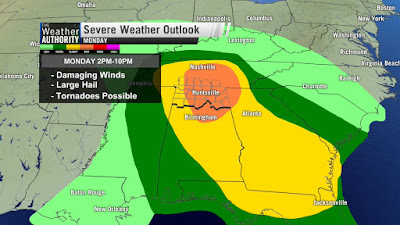 |
| The long-range forecast map |
It seems that just about anywhere you choose to live, there are issues with some kind of unpleasant weather. I grew up in Upstate New York. We had our share of blizzards and plenty of lake-effect snow. Our summers could be sweltering and terribly humid. When the Navy sent me to Norman, Oklahoma, I quickly learned why the government established the National Weather Service Storm Prediction Center there. Later, when I lived on the Mississippi Gulf Coast, we had to be concerned about hurricanes. And for the last 40 years I've lived in the North Alabama/South Central Tennessee region known for its devastating tornadoes.
On more than one occasion, we've gone to our "Safe Place" at the bottom of the basement stairs, in an area reinforced by the structure surrounding the stairs and with a couple walls in most directions between us and the great outdoors. This past Monday turned to be one of those days.
Over the weekend, our local weather teams had been forecasting some nasty weather that could potentially breed some strong winds, large hail, and even a few tornadoes. Monday morning we started to see "closings" being announced by schools, businesses, and government offices. I've been working from home, so around 4:00 PM, I joined Mary Ann in front of the TV, where every local channel was totally devoted to weather coverage. Several cells popped up, mostly to the south of us, moving almost due east. Nothing appeared too threatening until this bad boy decided to rear its ugly head:
Bottom line was a tornado spotted on the ground near Ardmore, Tennessee, moving due east at 45 miles per hour. Note on the picture the location of our "Safe Place." Soon, we started to see reports of wind damage and very large hail in Russellville, AL and Athens, AL. There was a large tornado heading toward Cullman, AL as we decided to seek safety in the basement. The Ardmore twister was predicted to reach our area at 7:06 PM. "If you live anywhere between Hazel Green, AL and Parks City, TN, take shelter immediately! We have a tornado on the ground that has been sighted by storm chasers." It was eerily quiet in the basement. We stayed there for about ten minutes, able to watch the live streaming of our favorite weathercaster on an iPad. We emerged to the first floor to find no issues. We soon learned that the storm had tracked a couple of miles south of us, where it wiped out some lumber storage warehouses:
Once again, we dodged the bullet and once again offered prayers of thanks.












